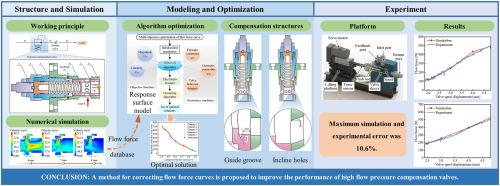基于流量力补偿与优化的大流量压力补偿阀结构设计
IF 2.7
3区 工程技术
Q2 ENGINEERING, MECHANICAL
引用次数: 0
摘要
航天器依靠脐带臂提供气体、输送电力和装载燃料。在升空前,这些臂必须迅速而平稳地缩回,这一过程由配备压力补偿阀(pcv)的流量控制阀控制。对于重型火箭,脐带臂需要更大的驱动功率,在大流量条件下,特别是在额定流量为800 L/min时,需要pcv进行稳定的压力补偿。然而,在这种情况下,PCV的阀芯受到显著的,高度非线性的流动力,使得难以实现与弹簧刚度的适当对准。这种不匹配严重影响了PCV的调压性能。为了增强大流量工况下的流力曲线与弹簧刚度的一致性,对所设计的空心阀芯PCV进行了初步有限元仿真。这些仿真提供了阀口结构参数与流量之间的映射数据,为建立流量曲线线性度和大小的响应面模型提供了依据。随后,设计了基于NSGA-II的多目标流力优化算法。对优化结构进行聚类分析后,流力曲线的线性度提高了43.6%。为了进一步减小阀芯的流量,提高阀芯的稳定性,基于优化后的几何形状设计了两种流量补偿结构。最大流力分别减小到494 N和530 N,分别减小29.7%和24.6%。最后,设计了大型流力测试平台,对两种方案在不同工况下的流力曲线进行了评价。结果表明,仿真与实验的最大偏差为10.6%,节流口压差稳定在0.7 MPa,流量波动在6.6%以内,验证了补偿设计的有效性。本研究为修正流量力曲线提供了一种研究方法,对提高大流量控制阀的稳定性具有重要意义。本文章由计算机程序翻译,如有差异,请以英文原文为准。

Structural design of a large flow pressure compensation valve based on flow force compensation and optimization
Spacecraft rely on umbilical arms to supply gas, deliver power, and load fuel. Moments before liftoff, these arms must swiftly and smoothly retract, a process managed by flow control valves equipped with pressure compensating valves (PCVs). For heavy-lift rockets, the umbilical arms require significantly greater driving power, necessitating stable pressure compensation by the PCVs under large flow conditions, particularly at a rated flow of 800 L/min. However, under such conditions, the spool of the PCV is subjected to significant, highly nonlinear flow force, making it difficult to achieve proper alignment with the spring stiffness. This mismatch severely impacts the pressure regulation performance of the PCV. To enhance the alignment between the flow force curve and spring stiffness under large flow conditions, finite element simulations were initially conducted on the designed hollow-spool PCV. These simulations provided mapping data between the valve port structural parameters and flow force, which served as the basis for constructing response surface models for the linearity and magnitude of the flow force curve. Subsequently, a multi-objective flow force optimization algorithm based on NSGA-II was designed. After clustering analysis of the optimized structures, the linearity of the flow force curve improved by 43.6 %. To further reduce the magnitude of the flow force and enhance spool stability, two flow force compensation structures were designed based on the optimized geometry. The maximum flow forces were reduced to 494 N and 530 N, representing decreases of 29.7 % and 24.6 %, respectively. Finally, a large flow force testing platform was designed to evaluate the flow force curves of the two schemes under various operating conditions. The results demonstrated a maximum deviation of 10.6 % between simulation and experiment, and the measured pressure differential across the throttling port remained stable at 0.7 MPa and a flow rate fluctuation within 6.6 %, confirming the effectiveness of the proposed compensation design. This study provides a research method for correcting flow force curves and has significant implications for improving the stability of large flow control valves.
求助全文
通过发布文献求助,成功后即可免费获取论文全文。
去求助
来源期刊

Flow Measurement and Instrumentation
工程技术-工程:机械
CiteScore
4.30
自引率
13.60%
发文量
123
审稿时长
6 months
期刊介绍:
Flow Measurement and Instrumentation is dedicated to disseminating the latest research results on all aspects of flow measurement, in both closed conduits and open channels. The design of flow measurement systems involves a wide variety of multidisciplinary activities including modelling the flow sensor, the fluid flow and the sensor/fluid interactions through the use of computation techniques; the development of advanced transducer systems and their associated signal processing and the laboratory and field assessment of the overall system under ideal and disturbed conditions.
FMI is the essential forum for critical information exchange, and contributions are particularly encouraged in the following areas of interest:
Modelling: the application of mathematical and computational modelling to the interaction of fluid dynamics with flowmeters, including flowmeter behaviour, improved flowmeter design and installation problems. Application of CAD/CAE techniques to flowmeter modelling are eligible.
Design and development: the detailed design of the flowmeter head and/or signal processing aspects of novel flowmeters. Emphasis is given to papers identifying new sensor configurations, multisensor flow measurement systems, non-intrusive flow metering techniques and the application of microelectronic techniques in smart or intelligent systems.
Calibration techniques: including descriptions of new or existing calibration facilities and techniques, calibration data from different flowmeter types, and calibration intercomparison data from different laboratories.
Installation effect data: dealing with the effects of non-ideal flow conditions on flowmeters. Papers combining a theoretical understanding of flowmeter behaviour with experimental work are particularly welcome.
 求助内容:
求助内容: 应助结果提醒方式:
应助结果提醒方式:


